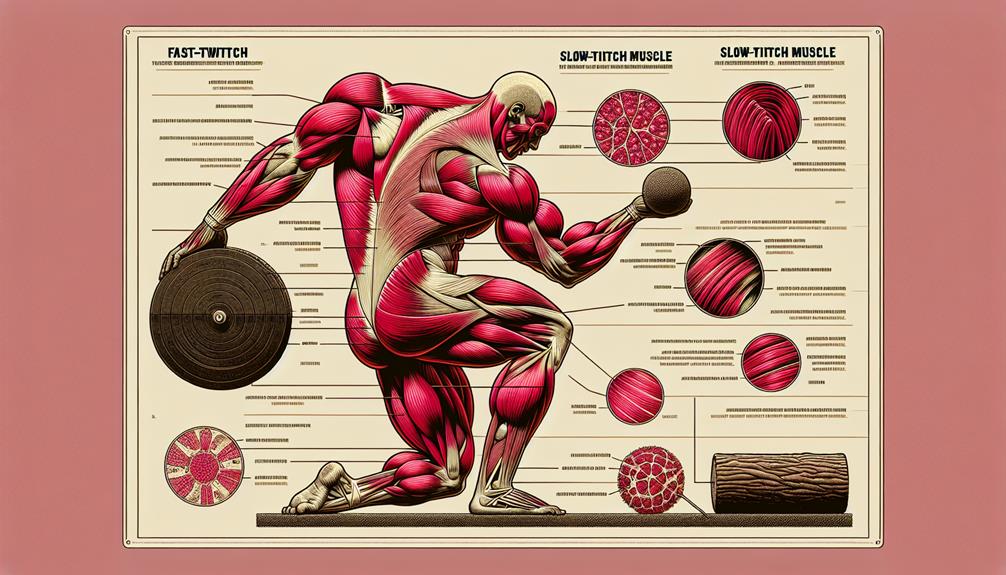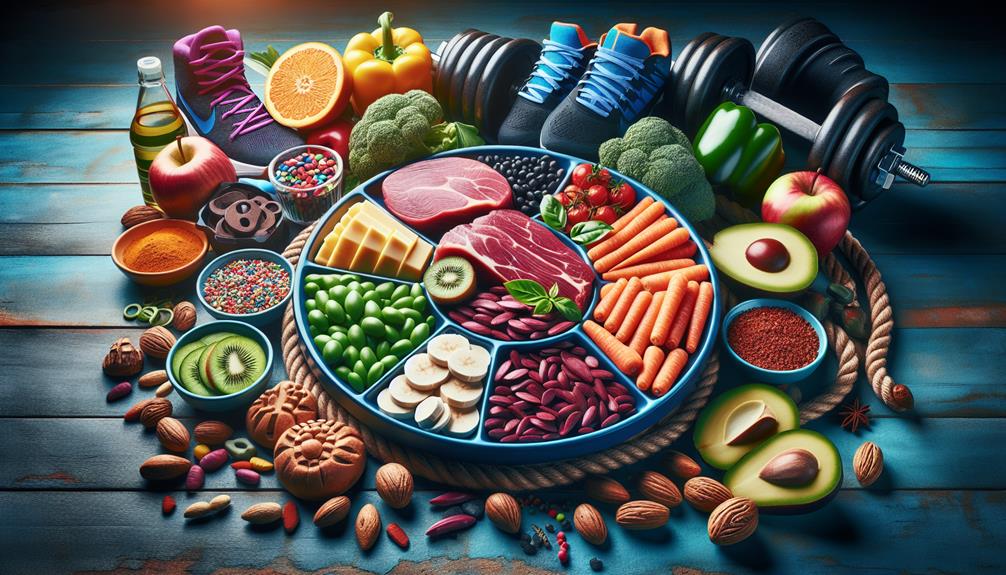Have you ever wondered how strongmen are able to perform incredible feats of strength and endurance? Take, for example, the case of Tom, a strongman competitor who is known for his ability to deadlift twice his body weight. What is it about his physiology that allows him to achieve such remarkable feats? In this discussion, we will explore the science behind strongman performance, examining the role of muscle fiber types, biomechanics, nutrition, cardiovascular adaptations, and mental toughness. By understanding the intricate interplay of these factors, we can gain insight into the physiological mechanisms that underpin the extraordinary abilities of strongmen. So, let's unravel the science behind the strength and performance of these mighty athletes.
Key Takeaways
- Developing both slow-twitch and fast-twitch muscle fibers is crucial for maximum strength gains in strongman performance.
- Proper biomechanics, including leverage and efficient use of muscles and joints, play a significant role in strongman events.
- Nutrition and energy systems, such as balanced caloric intake, hydration, and post-workout fueling, are essential for supporting muscle growth and optimizing performance.
- Adaptations of the cardiovascular system, including increased cardiac output and blood volume, improved blood flow, and enhanced oxygen delivery to muscles, are important for strongman performance.
Muscle Fiber Types and Strength

Understanding the different muscle fiber types is crucial for gaining strength in strongman training. When it comes to muscle fibers, there are two main types: slow-twitch (Type I) and fast-twitch (Type II). Slow-twitch fibers are responsible for endurance activities, such as long-distance running or cycling. On the other hand, fast-twitch fibers are responsible for explosive movements, like sprinting or weightlifting. In strongman training, it is important to develop both types of muscle fibers to maximize strength gains.
To build strength in strongman training, you need to focus on developing your fast-twitch muscle fibers. These fibers have a greater capacity for growth and are capable of generating more force. Heavy lifting exercises, such as deadlifts and squats, are great for targeting fast-twitch fibers. By lifting heavy weights, you put a significant amount of stress on your muscles, forcing them to adapt and grow stronger.
In addition to heavy lifting, incorporating explosive exercises into your training routine can also help develop your fast-twitch muscle fibers. Exercises like power cleans or kettlebell swings require quick and powerful movements, activating your fast-twitch fibers. By training these fibers, you can improve your strength and power, which are essential in strongman competitions.
The Role of Biomechanics in Strongman Performance
Biomechanics play a crucial role in maximizing strongman performance. By understanding and applying the principles of biomechanics, you can optimize your body's movements to generate maximum force and power. One important aspect of biomechanics is leverage. The strongman events often involve lifting and moving heavy objects, and having good leverage can make a significant difference in your performance. For example, when performing a deadlift, the position of your hips, knees, and back can determine how efficiently you can lift the weight. By keeping your back straight and your hips and knees in the optimal position, you can generate more force and lift heavier loads. Another key factor in strongman performance is body mechanics. Having proper body mechanics means using your muscles and joints in the most efficient and effective way possible. This includes maintaining good posture, engaging the right muscles at the right time, and minimizing unnecessary movements. By mastering your body mechanics, you can improve your overall performance and reduce the risk of injury. In summary, understanding and applying the principles of biomechanics can greatly enhance your strongman performance by optimizing leverage and body mechanics.
Fueling the Strongman: Nutrition and Energy Systems

To optimize your performance as a strongman, it is crucial to understand the importance of nutrition and how it fuels your body's energy systems. What you eat and drink directly impacts your ability to perform at your best and recover effectively. Here are five key points to consider when it comes to fueling your strongman training:
- Adequate Caloric Intake: Strongman training places high demands on your body, requiring a sufficient amount of calories to support muscle growth, repair, and overall energy expenditure.
- Macronutrient Balance: A balanced intake of protein, carbohydrates, and fats is essential for meeting the energy needs of your workouts, promoting recovery, and optimizing performance.
- Hydration: Staying properly hydrated is crucial for maintaining optimal performance and preventing dehydration, which can negatively impact strength, power, and endurance.
- Meal Timing: Properly timing your meals and snacks around your training sessions can help maximize performance and recovery by providing the necessary fuel and nutrients at the right times.
- Nutrient Timing: Consuming carbohydrates and protein immediately after your training session can help replenish glycogen stores and support muscle recovery.
Adaptations of the Cardiovascular System in Strongmen
As you continue to focus on fueling your strongman training, it is important to consider the adaptations of the cardiovascular system that occur in response to this intense physical activity. Your cardiovascular system, which includes your heart, blood vessels, and blood, plays a crucial role in supplying oxygen and nutrients to your muscles during exercise.
One key adaptation that occurs in the cardiovascular system is an increase in cardiac output. This refers to the amount of blood pumped by your heart per minute. With regular strongman training, your heart becomes stronger and more efficient, allowing it to pump more blood with each beat. This means that more oxygen and nutrients can be delivered to your working muscles, enhancing their performance.
Another adaptation is an increase in blood volume. Over time, your body produces more red blood cells and increases the plasma volume in your blood. This leads to an increase in total blood volume, allowing for greater oxygen-carrying capacity. As a result, your muscles receive more oxygen, enabling them to work harder and for longer periods of time.
Furthermore, strongman training also promotes the development of new blood vessels, a process known as angiogenesis. This helps to improve blood flow to the muscles and enhances the delivery of oxygen and nutrients. Additionally, the cardiovascular system adapts by increasing the efficiency of oxygen extraction at the muscle level, meaning that your muscles can utilize oxygen more effectively.
Mental Toughness and Its Impact on Strongman Performance

Developing mental toughness is crucial for strongman athletes as it directly impacts their performance in competitions. In order to excel in the world of strongman, you need to cultivate a strong mindset that can withstand the physical and mental challenges that come with the sport. Here are five key aspects of mental toughness that can significantly influence your performance:
- Resilience: Strongmen often face setbacks and obstacles, but it's important to bounce back and maintain focus on the goal.
- Focus: Maintaining concentration during events is vital for executing techniques and strategies effectively.
- Confidence: Believing in your abilities and having a positive mindset can enhance performance and help overcome self-doubt.
- Motivation: Staying motivated and driven is essential for consistent training and improvement.
- Adaptability: Strongman competitions can be unpredictable, so having the ability to adapt to different situations and adjust strategies is crucial.
Frequently Asked Questions
What Are the Most Effective Exercises for Increasing Muscle Fiber Types and Strength in Strongman Athletes?
To increase muscle fiber types and strength, you should focus on exercises like deadlifts, squats, overhead presses, and carries. These compound movements engage multiple muscle groups and promote overall strength development for strongman athletes.
How Can Understanding Biomechanics Help Improve Specific Strongman Performance Events?
Understanding biomechanics can greatly improve your performance in specific strongman events. By analyzing the forces and movements involved, you can optimize your technique, leverage your strengths, and minimize the risk of injury.
Are There Any Specific Dietary Recommendations or Supplements That Can Enhance Strongman Performance?
To enhance your strongman performance, consider specific dietary recommendations and supplements. These can provide the necessary nutrients and energy to support your training and help you reach your full potential.
How Does the Cardiovascular System Adapt and Improve in Response to the Demands of Strongman Training?
When you engage in strongman training, your cardiovascular system adapts and improves to meet the demands. It becomes more efficient at delivering oxygen and nutrients to your muscles, leading to enhanced endurance and performance.
What Strategies Can Strongman Athletes Use to Develop Mental Toughness and Improve Their Performance?
To improve your performance and mental toughness in strongman, try visualization techniques to mentally prepare for the challenges ahead. According to research, athletes who use visualization consistently perform better than those who don't.
Conclusion
You are the mighty oak tree, rooted deep in the earth, your branches reaching towards the sky. Just as the tree grows stronger with time, so do strongmen through their understanding of muscle fiber types, biomechanics, nutrition, energy systems, and mental toughness. Like the interconnected branches and roots, these elements work together to create a powerful force. Embrace the science of strongman and unlock your true potential, standing tall amidst the challenges that come your way.













